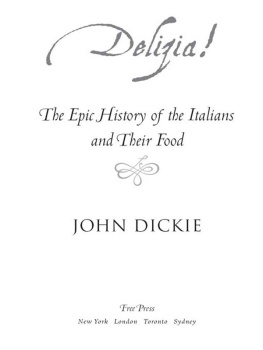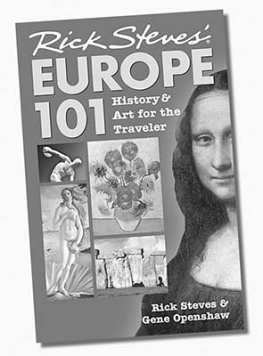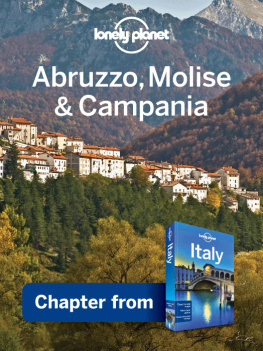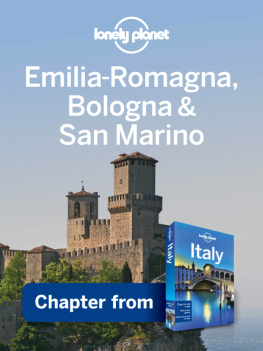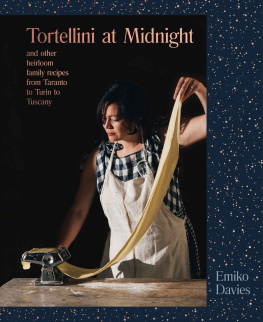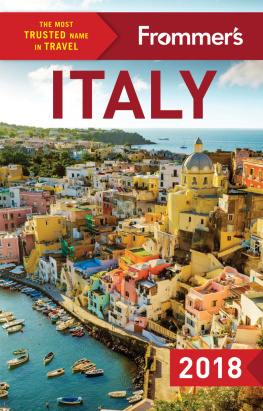Also by John Dickie
Cosa Nostra: A History of the Sicilian Mafia

Free Press
A Division of Simon & Schuster, Inc.
1230 Avenue of the Americas
New York, NY 10020
Copyright 2008 by John Dickie
All rights reserved, including the right to reproduce this book or portions thereof in any form whatsoever. For information address
Free Press Subsidiary Rights Department,
1230 Avenue of the Americas, New York, NY 10020
FREE PRESS and colophon are trademarks of Simon & Schuster, Inc.
Library of Congress Cataloging-in-Publication Data
Dickie, John.
Delizia!: the epic history of the Italians and their food/John Dickie.
p. cm.
1. GastronomyItalyHistory. 2. Food habitsItalyHistory. 3. Cookery, ItalianHistory. 4. ItalySocial life and customs. I. Title.
TX641 .D44 2008
641'.013dc22
2007015302
ISBN-13: 978-1-4165-5400-4
ISBN-10: 1-4165-5400-9
P ICTURE C REDITS
Archive of the State of Bologna: Archive of the State of Modena: Archivio Touring Club Italiano/Alinari Archive, Florence: (below); Bridgeman Art Library/Bibliothque National de France: (above); Bridgeman Art Library/Galleria e Museo Estense, Modena: Bridgeman Art Library/Muse des Beaux-Arts, Mulhouse: Bridgeman Art Library/Osterreichische Nationalbibliothek, Vienna: (below); Bridgeman Art Library/Vatican Museums and Galleries, Vatican City: British Library: Courtesy Slow Food, Bra.: Photo by Soldati:
Courtesy of author: in frontmatter (above and below).
Visit us on the World Wide Web:
http://www.SimonSays.com
For Sarah, Elliot, and Charlotte
Tuscany
Dont Tell the Peasants
A drive through the country between Siena and the sea in the sunshine of an autumn evening. The Tuscan hills undulating past the car window become harsher, shading from vines and olive groves into pockets of dark forest. The destination is remote, yet it is a place where you can hear accents and dialects from across Italy. Here Venetians mix with Neapolitans, Palermitans with Turinese. In this quiet corner of Tuscany a people divided by ancient local rivalries comes to pay homage together at an altar to their common cult of food.
The building lies in the valley below the perfectly preserved medieval town of Chiusdino, but it is not easy to find. Not long ago, the track leading to it was nearly lost in thick scrub. Even now many people miss the discreet road sign. When the more observant visitors have negotiated a tight, descending corner and nosed over the narrow, parapet-less bridge, they are rewarded with the sight of a riverside field of Jerusalem artichokesyellow flowers craning toward the setting sun.
Then it appears, unwelcoming at first, resolutely turning its worn back to the outside world, as if hiding its famous face among the poplar trees. But recognition chimes the moment the corner is turned: a simple brick and stone structure, with a shallow roof and an unassuming tower; at its flank a mill wheel is gently propelled by the limpid waters of the river Merce. It was built by monks from the nearby San Galgano Abbey in the early thirteenth century. Even today one can easily imagine a friar emerging from the beamed kitchen with an armful of cheeses and salami for his brothers. Or a peasant patriarch, his shoulder bowed by the weight of his hoe, trudging through the surrounding glade at the end of his days toil. Perhaps the plates and glasses on the table under the pergola were set by his homely wife for their extended family. Dinner is still awhile away, but already the air is laced with appetizing smells.
To the foreign visitor, Il Mulino Bianco , the White Mill, seems to typify everything that Italian food should be. To Italians, it is one of the most iconic buildings in the land.
Yet it is also Italys best-loved fake.
I TALIANS eat lots of biscuits (cookies), mostly for breakfast. In 1989, the leading biscuit brand, Mulino Bianco, was looking for a set for its new advertising campaign. The White Mill shown on the biscuit packets was about to become a real place. The industrialized Po valleyflat and featurelesshad distinctly the wrong image, thus ruling out locations in the region around Parma where the biscuits were actually made. Instead set researchers found what they were looking for, abandoned and almost derelict, off the Massetana road near Chiusdino in Tuscany. The old building was given a coat of white paint and a new mill wheel powered by an electric motor. In a short time it was ready to receive its imaginary family of owners. Dad was a square-jawed journalist; Mum, a pretty but prim teacher; their children, Linda with curly hair and a bonnet, and Andrea in slacks and a tie, were as smart-but-casual as their parents; a marshmallow-eyed grandfather completed the group. This, as the company Web site would have it, was a modern family who leave the city and choose to live healthily by going back to nature. Their story, to be told in a series of mini-episodes, was to embody the second-home aspirations of millions of urban consumers. And to tell it, the agency hired two of the biggest talents in Italian cinema: Giuseppe Tornatore, fresh from winning the Oscar for best foreign film with Cinema Paradiso; and Ennio Morricone, famed for his scores to the spaghetti westerns (among other things).
The result, between 1990 and 1996, was perhaps the most successful campaign in the history of Italian television. So successful, in fact, that droves of people from traffic-clogged Naples, Rome, and Milan started to search the hills of Tuscany for the White Mill they had seen in the biscuit ads. Queues of cars stretched back to the ruins of the San Galgano Abbey. Visitors approached the site in reverential silence as if they were entering a shrine. The mills owner recalls: There were real processions. Hundreds of people came to visit the mill at weekends. Most of them were disappointed because obviously it wasnt like it was on television. Only the kids were happy: they ran around enthusiastically amid all the plasterboard and polystyrene.
After the last Mulino Bianco advertisement had been filmed in 1996, the White Mill changed again; it was transformed into another, more tasteful manifestation of the Italian rural idyll. The owner spent four years restoring it and converting it into an agriturismo the kind of rustic hotel-restaurant that has become so popular in Italy over the last twenty years or so. The building reverted to its old name, Il Mulino delle Pile the Battery Mill (it used to supply electricity to Chiusdino before the war). A swimming pool was put in and the stonework sandblasted clear of paint. But even if it is now no longer white, the White Mill still answers to the same nostalgia for country food as does the brand that made it famous. It still attracts plenty of people who want to hold celebratory banquets for their weddings, birthdays, and anniversaries where the ads were set. Children still ask the owner whether he is the one who makes all the biscuits.
The rooms in the agriturismo Mulino delle Pile conform to an ideal of simple country elegance. The menu in its Old Grindstone Restaurant conforms to current canons of what is good to eat: authentic, typical Tuscan cuisine, based on fresh, seasonal produce. An antipasto of Tuscan sliced salami and hams, or pecorino cheese with honey. A primo of tagliatelle with wild boar rag boar is a speciality. A secondo of Sienese entrec te, or beef braised in Morellino wine, or local sausages with beans. A dessert of Vin Santo and cantucci biscuits.


